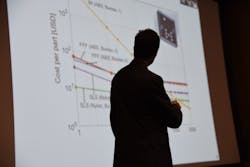More than 1,000 people from all over the world got a crash course in additive manufacturing (AM) during a recent virtual workshop hosted by MIT Professional Education. More commonly known as 3D printing, additive manufacturing is increasingly used a greater range of industries and applications to produce parts with greater speed, improved economics and performance, and in order to customize products for the individual consumer.
MIT is often credited with inventing 3D printing. Two professors, Ely Sachs and Michael Cima, used 3D printing to create a scale model of the main building at MIT building more than two decades ago using a process now known as binder jetting, but there were even earlier pioneers. Scientists began exploring the subject as early as 1980.
“So, we have a long history of invention and inspiration, but only now, in the past few years I’d say, are we turning the corner from prototyping to production,” says John Hart, an associate professor of mechanical engineering at MIT and director of the Center for Additive and Digital Advanced Production Technologies (ADAPT). “That’s really significant to me and significant to the industry.”
Hart led the virtual MIT Professional Education workshop. After taking participants through a brief history of additive manufacturing, he delved deeper into the subject, showing how things have changed over the past 30 years and explaining why it is increasingly relevant as a production method today.
In the beginning, 3D printing was primarily used to make prototypes of new products, but today it is also being used in volume production. It has the potential to save businesses time and money, and—most importantly—to redefine the axes upon which products are evaluated for a given use.
“Rapid prototyping will always be an advantage of 3D printing,” Hart says, “but it has now moved beyond that limited scope. In some cases, additive is not only more affordable, but can also produce better-quality parts because of the inherent geometrical freedoms that AM allows.”
Conventional processes such as injection molding or casting are highly efficient at producing large quantities of a fixed geometry at a low price. But with this cost advantage comes a striking disadvantage: Producing a variable product line, or parts in low quantities, requires large initial investments which may not be amortized over the cost of many individual units. Thus, companies are constrained to produce parts and products which conform to the economics of these conventional methods.
Additive manufacturing fundamentally changes this dynamic, as it can be leveraged to create variable quantities of complex or customized parts without the need for a fixed investment in tooling. In many cases, these parts could not be manufactured by any other accessible means. As a result, modern manufacturing is experiencing a renaissance, where design, creativity, and the customer voice couple with additive processes to create parts which were economically or physically impossible a decade ago.
Once on the fringes of production, additive manufacturing is opening up new possibilities not just for the shape and function of physical objects, but for the models upon which companies deliver value to their customers.
Hart points to Mercedes-Benz as an example. The automaker is using AM to reduce inventory costs and, in doing so, is digitizing its entire library of drawings for parts and turning paper drawings into digital 3D models.
“When folks need a part for their 30-year-old truck that’s broken down in a rural environment, Mercedes won't have to worry about having the inventory in stock and shipping it around the world,” Hart explains. “Instead, they might download a file from their digital library and print the replacement part, fully bespoke, at a location proximate to its final use. It should save them money in warehousing costs, but also get needed parts into the hands of consumers faster—and, depending on the application, perhaps at better quality.”
Hart says we do not yet know the long-term implications of AM because the industry is growing and developing so rapidly. That said, he wants executives to understand that AM can compete with conventional production methods when the business case is clear—either through enhanced performance, specific application space, or due to part volumes—and hopes that learners walk away from the workshop feel emboldened to use their imagination to define new possibilities for value creation.
Ultimately, he says, digital manufacturing requires confidence and know-how, and the convergence of both will mold the next generation of production.
The 90-minute virtual learning session gave participants a glimpse into the world of 3D printing. People who want to learn more about the process and the possibilities can enroll in Professor Hart’s five-day Professional Education course, Additive Manufacturing: From Prototyping to Production, which takes place on MIT’s campus in Cambridge this summer. Or enroll in his newest online course, Additive Manufacturing for Innovative Design and Production.



